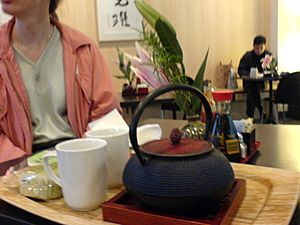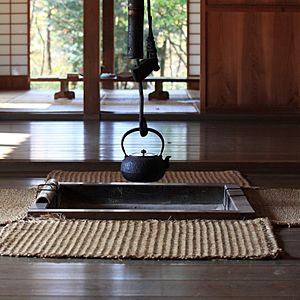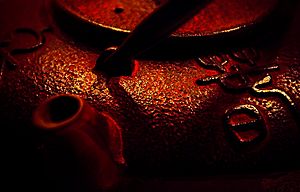Tetsubin facts for kids
A tetsubin (鉄瓶) is a special Japanese kettle made from cast iron. It has a spout for pouring, a lid, and a handle that goes over the top. People use tetsubin to boil and pour hot water, especially for making tea.
Traditionally, tetsubin are heated over charcoal fires. In the Japanese art of chanoyu, which is a formal way of making and serving tea, a special portable stove called a binkake (瓶掛) is used for this.
Tetsubin often have beautiful designs carved into their outside surface. They come in many different sizes and shapes, which makes them popular with collectors. A small tetsubin might hold about 0.5 litres of water, while large ones can hold up to 5 litres.
The exact history of the tetsubin is not fully known. Some experts believe it came from an older type of water kettle called a tedorigama. This kettle was already used in chanoyu during the time of Sen no Rikyū (1522–91), a famous tea master. In the 1800s, as drinking tea became more popular, tetsubin were seen as more than just kitchen tools. They became a status symbol, showing a person's importance.
Outside Japan, you might see cast-iron teapots that look a lot like tetsubin. These teapots have a smooth, glass-like coating called enamel on the inside. This makes them good for brewing tea. However, you cannot use these teapots to heat water directly, because the heat would damage the enamel coating. In Western countries, these teapots are often called tetsubin. But in Japan, they are called "tetsukyūsu" (鉄急須), which means "iron teapot," to show they are different from the kettles. These cast-iron teapots often come with a tea strainer inside.
The regions of Iwate and Yamagata in Japan are famous for making both tetsubin kettles and iron teapots.

Contents
The History of Tetsubin Kettles
It's not completely clear when the first tetsubin kettles appeared in Japan. One idea is that their popularity grew along with a type of leaf tea called sencha. China introduced sencha to Japan around the mid-1600s.
How Sencha Tea Made Tetsubin Popular
At first, sencha was not as formal as matcha, which was the common powdered green tea back then. Throughout the 1700s, people started drinking sencha in more relaxed settings. It became a way to share tea with friends or family. As more people enjoyed sencha, the tetsubin became more popular too.
Tetsubin's Relatives
The tetsubin design probably wasn't completely new. It was likely influenced by other kettles used at the time. Five kettles that are very similar to the tetsubin are the tedorikama, the toyama, the mizusosogi, the dobin, and the yakkan.
The yakkan is the closest relative to the tetsubin. The main difference is that the yakkan is made from copper, while tetsubin are traditionally made from iron. Some people wondered why the tetsubin was created when the yakkan already worked well. Tea drinkers might have preferred the taste of water heated in an iron kettle over water from a copper kettle.
Tetsubin as a Household Item
During the 1700s, tetsubin kettles became a common item in Japanese homes. They were used for heating water to make tea. As more people used these kettles, their designs became more detailed. In the 1800s, tetsubin designs changed from simple iron kettles to beautifully decorated works of art.



